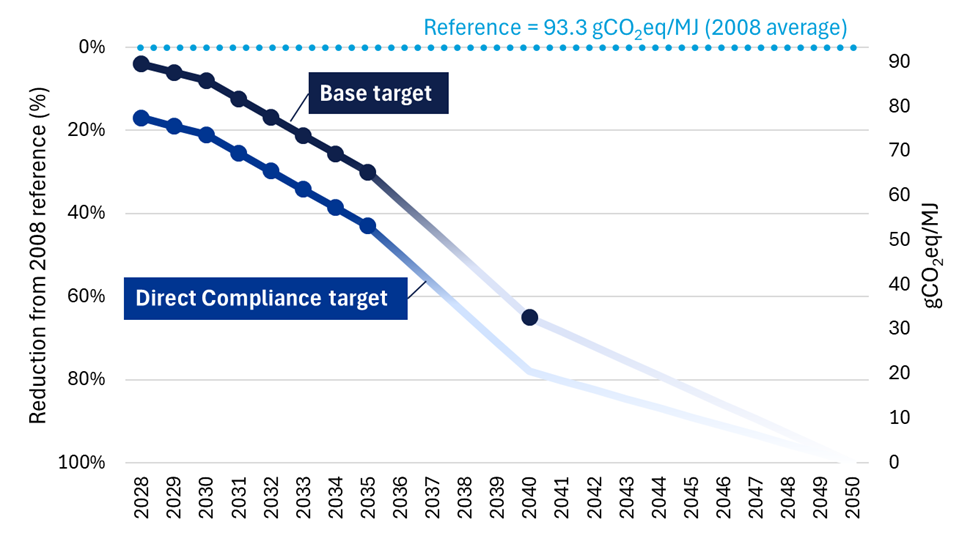GHG Fuel Intensity (GFI)
The NZF includes two interlinked elements:
- A technical element, setting gradually more stringent reduction requirements to a ship’s annual GFI
- An economic element, including a two-tiered pricing of GHG emissions above the GFI requirements, whereby the proceeds go towards rewards for use of zero or near-zero GHG emission fuels and to support the implementation of the NZF
The new regulations apply to all ships over 5,000 GT. They do not apply to ships trading solely domestically, as well as platforms including FPSOs, FSUs and drilling rigs, and semi-submersible vessels.
The requirements are based on a GFI metric measured in life-cycle GHG emissions per unit of energy used on board a ship (gCO2eq/MJ), including electricity delivered to the ship, wind propulsion and solar power.
The GHG emissions are calculated from a well-to-wake perspective, including emissions related to extraction, cultivation, production and transportation of the fuel, in addition to emissions from combustion or conversion of the energy, and any methane slip, on board the ship.
How electricity is delivered to the ship, wind propulsion and solar power will be accounted for is yet to be decided and therefore not covered in guidelines. For example, for wind propulsion, the guidelines will specify whether the energy provided should be measured through design criteria or through on-board measurements.
Two tiers of requirements have been set for the annual attained GFI for a ship: a Base target and a more stringent Direct Compliance target. The targets are set relative to the average well-to-wake GFI of the fleet in 2008 of 93.3 gCO2eq/MJ. Each ship is required to meet the Direct Compliance target, either by reducing its attained GFI, by purchasing Remedial Units (RU) from the IMO Net-Zero Fund or transfer of Surplus Units (SU) from other ships.
The regulations include annual GFI reduction factors to 2035, as shown below. The Base target for 2040 is set to 65%, while the annual reduction targets for the years 2036 to 2040 for both sets of targets will be negotiated by the MEPC by 1 January 2032.

| Year | 2028 | 2029 | 2030 | 2031 | 2032 | 2033 | 2034 | 2035 | ... | 2040 |
| Base | 4% | 6% | 8% | 12.4% | 16.8% | 21.2% | 25.6% | 30% | 65% | |
| Direct | 17% | 19% | 21% | 25.4% | 29.8% | 34.2% | 38.6% | 43% | - |
Based on the attained GFI and the targets, each ship will have to determine an annual compliance balance, expressed in tonnes of CO2eq. If a ship has a GFI lower than the Direct Compliance target, it will receive SUs. Conversely, if a ship has a GFI above the Direct Compliance target, it has a negative compliance balance and accrues compliance deficits.
A ship with a compliance surplus can transfer SUs to ships with a compliance deficit (similar to the FuelEU Maritime’s concept of compliance pooling), it can bank the SUs for later use within the two subsequent calendar years, or it can cancel the SUs as a voluntary mitigation contribution. Note that an SU can only be transferred once and can only be transferred to balance a Tier 2 compliance deficit.
A ship can balance its Tier 2 compliance deficit with SUs from other ships, or it can buy Remedial Units (RUs) (similar to the FuelEU Maritime’s penalty) from the IMO Net-Zero Fund. The Tier 1 compliance deficit can only be compensated by Tier 1 RUs – in other words, SUs from other ships cannot be used for Tier 1 compliance.
The initial RU prices for the reporting periods 2028 to 2030 are set as follows:
- Tier 1 RU: USD 100 per tonne of CO2eq
- Tier 2 RU: USD 380 per tonne of CO2eq
The MEPC will determine a mechanism by 1 January 2028 for reviewing and defining RU prices for 2031 and onwards.
More on the Net-Zero Framework
Decision on the IMO Net-Zero Framework delayed for one year
Read our Technical and Regulatory News from 17 October 2025
On-demand webinar: MEPC 83 summary: New regulations to reduce GHG
Get access to the recording and slidedeck
IMO’s new Net-Zero Framework: What you need to know
Listen to our podcast
IMO MEPC 83: GHG requirements approved, taking effect from 2028
Read our Technical and Regulatory News from 3rd April 2025
GHG regulatory outlook for 2025 – Major actions and deadlines
Read our Technical and Regulatory News from 4th February 2025
Related topics and services
IMO DCS – Data Collection System
Visit our topic page
MRV (EU and UK)
Visit our topic page
FuelEU Maritime
Visit our topic page
EU ETS – Emissions Trading System
Visit our topic page
Emissions Connect
ADVANCE from raw data to continuous business control